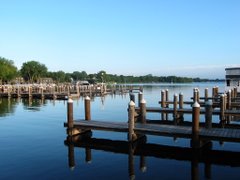This month, I will talk about the regulatory and cultural framework that has allowed aquatic invasive species (AIS) to move to and from lakes in Minnesota and elsewhere. Simply, Minnesotans have enjoyed our bountiful lakes and rivers and have had the ability to move among them unfettered. Unfortunately, AIS are exploiting these vectors by hitchhiking on boats and trailers – this is the main way AIS are moved from lake to lake. There is certainly a long tradition of and appreciation for this ability to enjoy our lakes, but it is time to re-examine this in light of these unwanted hitchhikers and the permanent damage they cause.
We cannot solve the AIS problem within the same framework that created it.
The Lake Minnetonka Association has developed a plan and vision embodied in our Milfoil-Free Minnetonka campaign. This plan contains recommendations for re-organizing agencies’ roles and specific funding mechanisms that ‘change the game’ in a way that we believe can keep unwanted AIS at bay and therefore protect our beautiful lake.
We have identified a need for an AIS management budget for Lake Minnetonka of at least $600,000 per year. This compares with current spending of about one third that amount. While $600,000 may seem high, our analysis shows this amount is appropriate for the need. Further, there are many examples of lake management efforts around the country that spend 10- and 20-times this amount on a per acre basis.
Where should we seek this additional money?
We recommend this money should come from or through the Lake Minnetonka Conservation District, the agency specifically empowered to protect Lake Minnetonka. The majority of new funding (75%) should come from an increased levy, access fees and the private Save-the Lake fund and remainder (25%) the Lake Minnetonka Association (25%).
Here is our rationale. The LMCD is charged with managing Lake Minnetonka for many things, including AIS. However, they have a cap on their funding levy, which critically impairs their ability to protect the lake. We have also heard from many member Cities that they should not be called upon to provide funding directly from their budgets; rather this is better managed by the LMCD. Thus, we are recommending a statute amendment that would raise the LMCD’s levy limit to provide for additional AIS funding. We also recommend a system of charging fees at accesses to supplement the LMCD’s AIS budget, believing this to be a fair and proportionate method for protecting the lake. This is done elsewhere and can be done in a way that does not unreasonably restrict public access. We also know from the Three Bay project that lakeshore residents will step up and voluntarily fund this important work. So, the Lake Minnetonka Association should also contribute funds. There may be other agencies or entities better suited to implementing this ambitious plan and these should be considered to assure Lake Minnetonka is best protected.
Our specific recommendations and complete plan will be available on our website soon.
While the AIS problem pervades many levels – local, state, regional, national - we believe the responsibility for protecting Lake Minnetonka must arise and be supported locally. As a practical matter, there is no really other alternative. Right now, the Minnesota’s state grant program for AIS control and protection is less than the $600,000 per year we have identified as the need for just Lake Minnetonka.
If we do not change the game, we cannot protect Lake Minnetonka.

